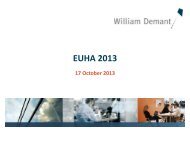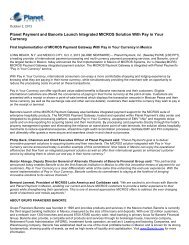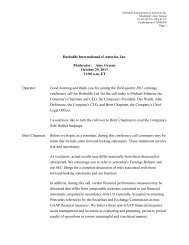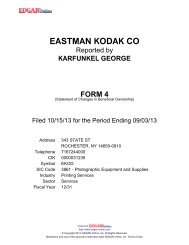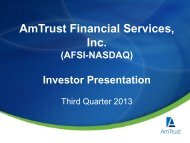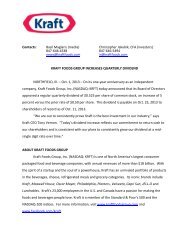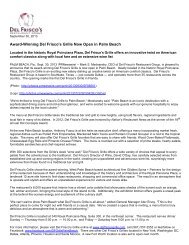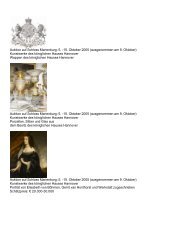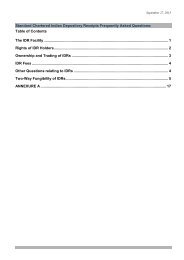matson, inc. form def 14a - Shareholder.com
matson, inc. form def 14a - Shareholder.com
matson, inc. form def 14a - Shareholder.com
Create successful ePaper yourself
Turn your PDF publications into a flip-book with our unique Google optimized e-Paper software.
estricted stock units, and 40 percent per<strong>form</strong>ance-based restricted stock units) and also resulted in lower award values than originally intended by the Committee by approximately 12<br />
percent, with the exception of Mr. Andrasick, per the terms of his Executive Transition Agreement. However, given the daily volatility of the stock market, the Committee agreed in advance<br />
that this was the most sensible approach at that time. (For 2010 awards, the Compensation Committee returned to its customary practice of approving awards based on dollar amounts.) In<br />
addition, beginning with the 2009 award, the Compensation Committee <strong>inc</strong>reased the vesting period for per<strong>form</strong>ance-based restricted stock units from one-year vesting to vesting in equal<br />
<strong>inc</strong>rements over three years. The Compensation Committee believed that the lengthened vesting period was in line with market practices, would strengthen alignment with shareholders and,<br />
through forfeiture conditions, strengthen retention of participants.<br />
Given the economic environment and stock price decreases, the Committee took into account various considerations when determining 2009 award amounts, <strong>inc</strong>luding but not limited<br />
to, shares available for grant under the 2007 Plan, reduced cash <strong>inc</strong>entive targets, the lack of salary <strong>inc</strong>reases for NEOs, the current stock price, base salary versus market <strong>com</strong>petitive data, and<br />
current survey data. The Committee used the most current survey data available (which was based on 2008 market data), but did not rely as heavily on a <strong>com</strong>petitive percentile target as in past<br />
years in making grant determinations due to expected differences between 2008 and 2009 survey data. At management’s re<strong>com</strong>mendation, the Committee targeted grants at or below the 50 th<br />
percentile of <strong>com</strong>petitive practices, as opposed to the 60 th percentile. However, the exact positioning was not known at the time of grant because 2009 survey data had not yet been published.<br />
Consistent with prior years, Towers Watson provided a guideline range for equity grants for the Compensation Committee to consider, as determined through survey sources available at that<br />
time (Watson Wyatt and Towers Perrin – see The Role of Survey Benchmarking on page 21).<br />
When <strong>com</strong>pared to the actual 2009 survey data when it became available, rather than 2008 data used, the 2009 equity awards were at about the 60 th percentile for Messrs. Doane and<br />
Kuriyama, about the 40 th percentile for Messrs. Benjamin and Cox, and about the 50 th percentile for Mr. Buelsing. Mr. Andrasick’s 2009 award, made in accordance with the terms of his<br />
Executive Transition Agreement, resulted in grants at the 55 th percentile. Upon his retirement on August 31, 2009, Mr. Andrasick’s per<strong>form</strong>ance-based and time-based restricted stock unit<br />
<strong>com</strong>ponents of his 2009 long-term <strong>inc</strong>entive award were subject to pro rata vesting under the terms of the 2007 Plan. In light of the valuable contributions Mr. Andrasick has made to the<br />
Company during his tenure, the vesting of an additional $50,000 of his time-based restricted stock unit award was accelerated in connection with his retirement.<br />
In line with the Committee’s intent to target the 50 th percentile, the 2010 equity awards as determined by the Committee were at about the 50 th percentile for Messrs. Kuriyama,<br />
Benjamin, and Mr. Cox and slightly under the 60 th percentile for Mr. Buelsing. Messrs. Doane and Andrasick did not receive a grant due to their retirement.<br />
For the 2009 per<strong>form</strong>ance-based restricted stock unit grants made in January 2009, three levels of per<strong>form</strong>ance goals were established based on corporate profit before <strong>inc</strong>ome tax and<br />
return on invested capital (ROIC) goals, as described in the previous “Company and Business Unit Per<strong>form</strong>ance” section: threshold, target and extraordinary. If the threshold level is not<br />
achieved, the grants are forfeited. Awards are prorated for per<strong>form</strong>ance between the threshold, target and extraordinary levels, as applicable. In 2009, the Company’s corporate per<strong>form</strong>ance was<br />
below the threshold levels for both measures, as discussed in the previous “Company and Business Unit Per<strong>form</strong>ance” section, and resulted in executives earning none of their targeted<br />
per<strong>form</strong>ance-based shares.<br />
Retirement Plans : The Company provides various retirement plans to assist its executives and other employees with retirement <strong>inc</strong>ome savings and <strong>inc</strong>rease the attractiveness of employment<br />
with the Company by providing a <strong>com</strong>petitive retirement package. None of the qualified or nonqualified retirement plans is tied directly to Company per<strong>form</strong>ance, with the exception of the A&B<br />
Profit Sharing Plan as described below. The Committee periodically reviews the value of benefits from the retirement plans in conjunction with all other <strong>form</strong>s of pay in making <strong>com</strong>pensation<br />
decisions.<br />
A&B Retirement Plan for Salaried Employees and Retirement Plan for Employees of Matson : The A&B Retirement Plan for Salaried Employees and Retirement Plan for Employees of<br />
Matson (“Qualified Retirement Plans”), which are tax-qualified <strong>def</strong>ined benefit pension plans, provide retirement benefits to the Company’s salaried non-bargaining unit employees. The Pension<br />
Benefits table of this Proxy Statement shows estimated present values of annual accrued retirement benefits of covered participants payable at age 62 (the earliest age at which benefits are<br />
unreduced), or current age, if older, under these plans.<br />
In 2007, the Compensation Committee and management worked with Towers Watson to review the design of these plans and amended them to apply a “cash balance” <strong>form</strong>ula for all<br />
salaried non-bargaining unit employees joining the Company after December 31, 2007. The decision to amend the plans was based on the need to provide a more attractive and portable plan to<br />
employees, improve asset management, mitigate financial risks, improve plan costs, <strong>inc</strong>rease employee responsibility in retirement planning and remove unintentional retention or early<br />
retirement <strong>inc</strong>entives. The Company intends to maintain the current calculation <strong>form</strong>ulas for employees hired prior to January 1, 2008, <strong>inc</strong>luding all the NEOs.<br />
Non-Qualified Benefits Plans : The Company has the following non-qualified benefits plans for executives that are designed to meet the retirement plan objectives described above.<br />
With the exception of the A&B Excess Benefits Plan, no new participants have been added s<strong>inc</strong>e 1997, and there are no plans to add any participants in the future.<br />
• A&B Excess Benefits Plan : Complements the Qualified Retirement Plans and A&B Profit Sharing Retirement Plan to provide benefits and contributions in an amount equal to what<br />
otherwise would have been provided using the Qualified Retirement Plans’ <strong>form</strong>ulas except for the contribution, <strong>com</strong>pensation and benefits limits imposed by tax law. All NEOs<br />
participate in this plan.<br />
• A&B Executive Survivor/Retirement Benefit Plan : Provides executives with either a death or retirement benefit. In 2009, this plan had three active participants, only one of whom,<br />
Mr. Doane, was an NEO. Participants may elect to receive the benefit as a lump sum, instead of a payout of monthly installments over ten years. As of February 2010, no NEOs are<br />
active participants in the plan.<br />
• A&B 1985 Supplemental Executive Retirement Plan : Enhances the Company’s ability to hire and retain executives who, because of a career change, would have less than a full<br />
service career with the Company. In 2009, this plan had three active participants, only one of whom, Mr. Doane, was an NEO. As of February 2010, no NEOs are active<br />
participants in the plan.<br />
A&B Profit Sharing Retirement Plan and Individual Deferred Compensation Plan: The Company has a per<strong>form</strong>ance-based Profit Sharing Retirement Plan available to all salaried nonbargaining<br />
unit employees that provides for discretionary contributions to participants of up to 3 percent of <strong>com</strong>pensation based on the degree of achievement of <strong>inc</strong>ome before taxes as<br />
established in the Company’s annual Board-approved operating plan. In 2009, available contributions were set between zero and three percent, and in 2010, the Plan was suspended. The<br />
Company also has an Individual Deferred Compensation Plan (a 401(k) plan), available to all salaried non-bargaining unit employees, that generally provides for a match of up to three percent of<br />
the <strong>com</strong>pensation <strong>def</strong>erred by a participant during the fiscal year. This match was suspended effective September 1, 2009.<br />
For 2009, the Compensation Committee determined that participants would not receive any profit sharing contribution, based upon the Company’s below-threshold per<strong>form</strong>ance for its<br />
profit before <strong>inc</strong>ome tax goal; however, the Company made matching contributions under the Individual Deferred Compensation Plan prior to suspension. The value of the Company’s 2009<br />
Individual Deferred Compensation matches for NEOs is <strong>inc</strong>luded in the Summary Compensation Table of this Proxy Statement.<br />
Employment Agreements: Except as set forth below, the Company does not provide employment agreements for any of the NEOs. The Company believes in a policy of “at will” employment.<br />
On August 28, 2008, as part of its executive succession planning and to provide for an orderly transition, Matson entered into an Executive Transition Agreement with Mr. Andrasick in<br />
which Mr. Andrasick, who was President and Chief Executive Officer of Matson, would serve as Matson’s Chairman of the Board from October 1, 2008 to August 31, 2009, at which time Mr.<br />
Andrasick retired from the Company. To recognize Mr. Andrasick for his past contributions to Matson and A&B, the Company determined that all elements of Mr. Andrasick’s <strong>com</strong>pensation<br />
would remain the same, <strong>inc</strong>luding an equity grant in 2009 at the same level of award as in 2008, with the number of options and shares to be determined by the methodology approved by the<br />
Compensation Committee and subject to the terms of the 2007 Plan.<br />
On October 22, 2009, as part of its executive succession planning and to provide for an orderly transition, the Company entered into an agreement with Mr. Doane in which he will be<br />
provided office space and parking at the Company’s offices in Honolulu, Hawaii, limited administrative support, and reimbursement for out-of-pocket expenses directly <strong>inc</strong>urred in providing<br />
assistance to the Company at its request. The agreement <strong>com</strong>menced on February 1, 2010 when Mr. Doane ceased to be an employee and ends on the later of (i) Mr. Doane’s 65th birthday<br />
(January 17, 2013) or (ii) Mr. Doane’s termination or retirement as a director of the Company.<br />
Executive Perquisites and Benefits : In the past, the Company provided limited perquisites as part of a <strong>com</strong>petitive pay package for executives. However, in 2009, the Company eliminated the<br />
bulk of such perquisites. In September 2009, the Company eliminated car allowances, financial planning services, <strong>com</strong>pany physicals and club memberships (with the exception of limited<br />
airline club memberships). The aggregate cost of providing perquisites to all NEOs in 2009 was less than $80,000 and is expected to be negligible in 2010.<br />
Severance Plan and Change in Control Agreements: The Company provides a Severance Plan and Change in Control Agreements to certain executives, <strong>inc</strong>luding each of the NEOs, to retain<br />
talent during transitions due to a Change in Control or other covered event and to provide a <strong>com</strong>petitive pay package. In particular, Change in Control agreements promote the continuation of<br />
management to ensure a smooth transition and protect the underlying stock value during the transitional period. The Compensation Committee designed the original agreement terms with the<br />
intent to provide a <strong>com</strong>petitively structured program, and yet be conservative overall in the size and amounts of potential award payouts. The Compensation Committee’s decisions regarding<br />
other <strong>com</strong>pensation elements are affected by the potential payouts under these arrangements, as the Committee considers how <strong>inc</strong>reases in the other pay <strong>com</strong>ponents will affect the size of the



